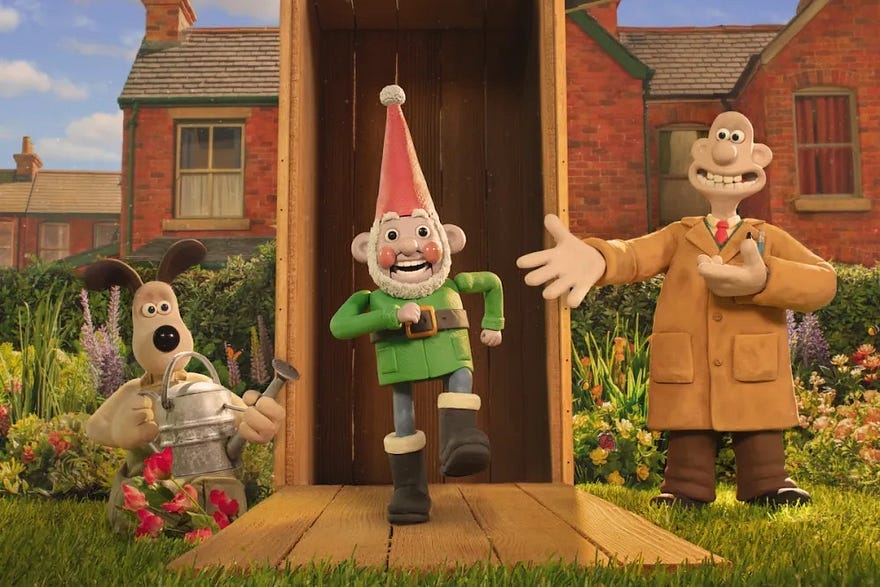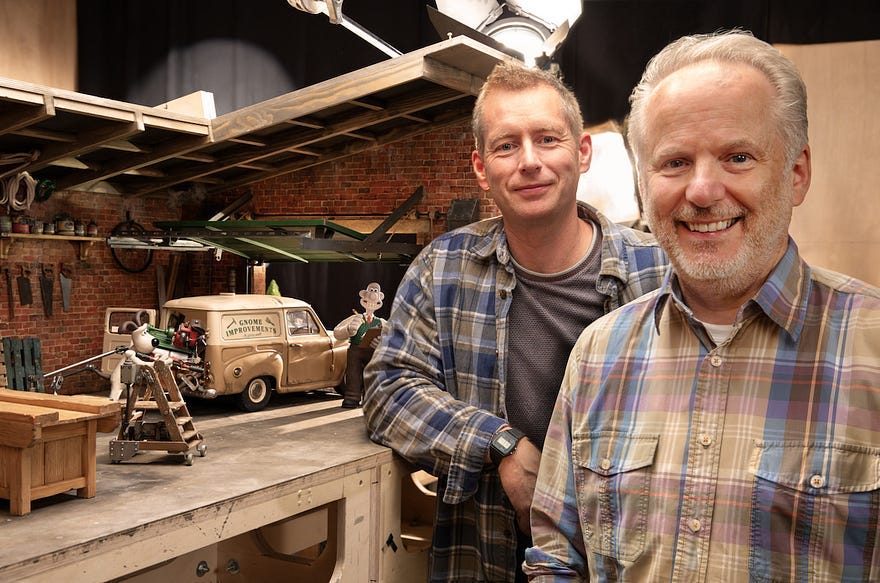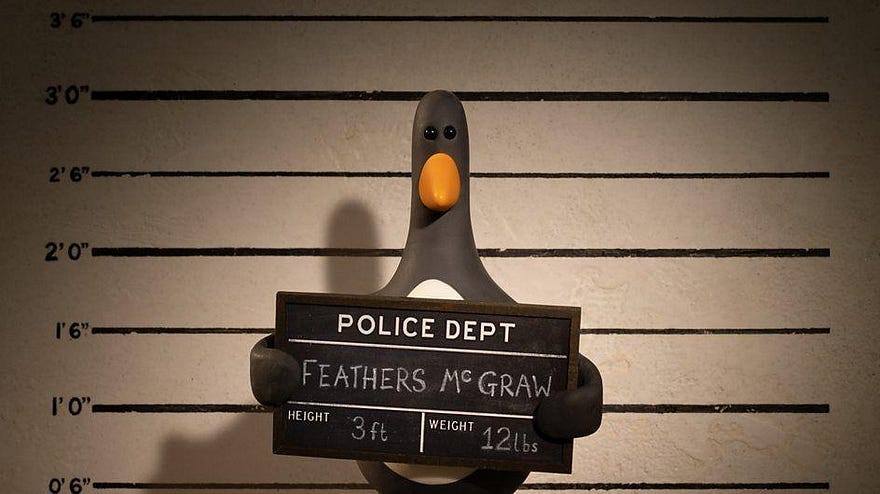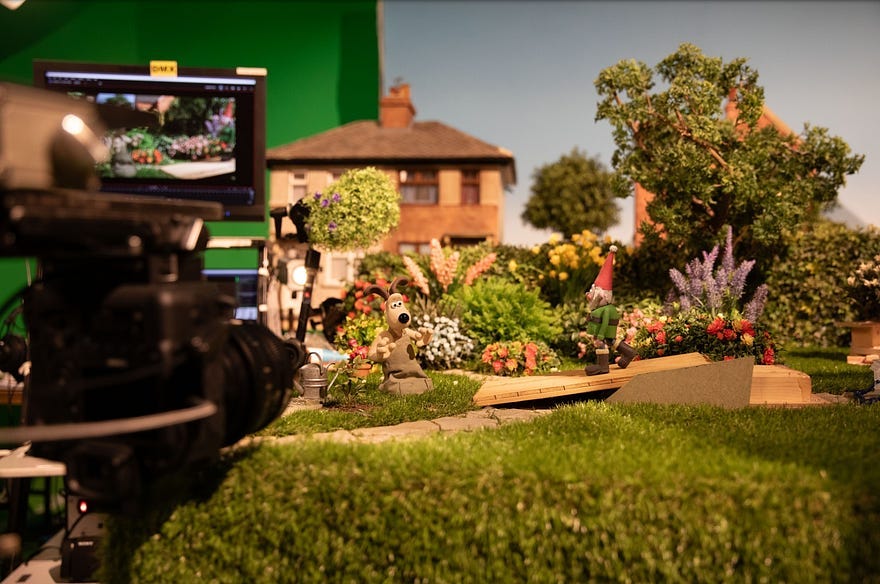The Gnome Noir of 'Wallace & Gromit: Vengeance Most Fowl'
Nick Park, Merlin Crossingham and Carla Shelley on sinister garden gnomes, sewer submarines and the return of Feathers McGraw.
The iconic animated duo Wallace and Gromit returns with another adventure in Wallace & Gromit: Vengeance Most Fowl, the latest claymation caper from Aardman, brimming with humor, charm, and a horde of sinister garden gnomes for good measure.
Though I’d seen snippets of these very British films years ago — along with plenty of Shaun the Sheep episodes on Norwegian television through the years — the Wallace & Gromit franchise had always sat firmly on my “This looks fun! I’ll get to it eventually” list. However, this year’s awards season, where I vote in the Golden Globe Awards, gave me the perfect opportunity to finally watch their newest adventure. Within minutes, I realized what I had been missing out on — this was all deliciously bonkers!
When I was invited to attend an online press conference with Wallace & Gromit creator Nick Park, animation director Merlin Crossingham (what an epic name!), and producer Carla Shelley, there really was only one option. Tuning in via Zoom, the session explored the inspiration, challenges, and outright silliness that shaped this latest entry in the iconic British claymation franchise.
But before we begin, this article includes some light spoilers from Wallace & Gromit: Vengeance Most Fowl, which premieres on Netflix January 3rd, 2025.
The Origins of Gnome Noir
Nick Park opened the discussion by reflecting on how far Wallace & Gromit had come since their humble beginnings. “I keep having to pinch myself,” he shared. “When I think back to my National Film School days and this was my college project… to see that they’ve become household names now is just phenomenal and unbelievable.”
On Wallace & Gromit: Vengeance Most Fowl, Park revealed that the idea had been floating around for years. “You can’t rush a good thing,” producer Carla Shelley added. “Nick’s love of gnomes in the Wallace & Gromit universe has been bubbling for a very long time.” This fascination eventually led to what the team affectionately calls “gnome noir.”
“We’ve accidentally invented a genre — gnome noir,” Park chuckled. “It’s a new subgenre of the thriller.” Animation director Merlin Crossingham elaborated: “We were inspired by Village of the Damned — those sinister kids walking around, turning their heads slowly. The gnomes are just like that.” With Feathers McGraw taking center stage, the film promises a bizarre and delightful blend of tension and absurdity.
Bond Villainy and Submarine Shenanigans
Nick Park recounted one of the film’s most delightfully absurd moments: Feathers McGraw at the controls of a bizarre sewer submarine constructed from stolen garden supplies. “It’s the kind of absurdity we love. Feathers McGraw is deadpan as always, but the situation around him is so ridiculous — a submarine in the sewers? With a pipe organ? It’s just too much fun.” Producer Carla Shelley added, “Feathers McGraw at the submarine pipe organ? That was one of Nick’s first drawings. It was an immediate green light moment for us.” The scene perfectly showcases Aardman’s knack for blending subtle character comedy with wildly over-the-top set pieces.
Another hilariously British moment sees Feathers McGraw going full Bond villain, complete with a white seal perched in his lap. “We wanted something absurd yet oddly fitting,” Park said, describing the homage. “The timing and visual comedy had us in stitches during production.”
Bringing back Feathers McGraw, the sinister penguin first introduced in The Wrong Trousers, came with its own set of challenges. “The biggest challenge on this film was Feathers McGraw,” Park admitted. “His strength comes from how little he does — a blink can mean a lot.” It’s this minimalism that has made Feathers such a memorable villain, and the team was eager to do him justice in his return.
Bringing Gromit to Life
Despite his owner being an inventor, it is his dog, silent companion and show-stealer Gromit who is arguably the brain in the duo. Animation director Merlin Crossingham shared his insights into the careful craft behind Gromit’s understated brilliance. “Less is always more. New animators always over-animate Gromit, and you don’t read him when that happens. His performance lies in subtlety,” he explained. Crossingham emphasized the challenge of imbuing the clay figure with a “thinking, breathing” presence that resonates so universally.
Nick Park reflected on Gromit’s unique origin story, sharing how a technical limitation back in the day led to the character’s defining trait. “In A Grand Day Out, Gromit originally had a mouth, but I couldn’t quite reach to animate it. So, I started moving his brow up and down. That moment gave birth to the Gromit we know today — more human than Wallace in many ways, sensitive and long-suffering.”
Crossingham built on this, highlighting how Gromit taps into a universal fantasy: that our pets might secretly understand everything we say. “I have a dog, and I talk to him like he’s human. I think that’s quite a common thing, and Gromit embodies that idea perfectly,” he said with a smile.
The enduring appeal of Gromit, Park noted, lies in his relatability. “Everyone has been in Gromit’s position at some point — being the quiet, intelligent one surrounded by chaos. He’s the audience’s anchor in these wild stories.” For the filmmakers, maintaining this emotional clarity required a delicate touch. Crossingham emphasized the importance of restraint: “The key to Gromit’s performance is holding back. It’s not easy, but it’s worth it when you see how much personality comes through in just a slight movement of the brow.”
British Humor and Subtle Puns
Wallace & Gromit wouldn’t be the same without their signature blend of clever wordplay, visual gags, and unabashed puns. “We’re not scared of a pun,” admitted Merlin Crossingham with a grin. “Shameless, really.” This unapologetic embrace of humor defines the series, and Vengeance Most Fowl is no exception.
Nick Park shared his delight at how British cultural references often find a home in the films, even when they don’t entirely translate. “We had a gag about a bolt chain — basically a toilet flush — which left our international colleagues baffled. But sometimes, you just have to lean into the absurdity.” This quintessentially British approach merges self-deprecation with irreverent humor, a combination that continues to charm audiences worldwide.
As for the aforementioned Bond-villain scene featuring Feathers McGraw and the white seal, Park shared, “We called him Ron Seal,” referencing the UK sealant brand. “It probably doesn’t travel, but it makes us laugh.” Crossingham added, “British humor thrives on these silly yet oddly fitting moments. If you’re laughing at us or with us, it doesn’t matter — as long as you’re laughing.”
A Study in Clay
Claymation is a labor of love — and madness. The team behind Vengeance Most Fowl reflected on the effort involved in bringing Wallace, Gromit, and their world to life. “If you step back, these films shouldn’t exist,” admitted animation director Merlin Crossingham. “The process is nuts — no sensible person would do it — but there’s passion driving it all.”
Nick Park elaborated on the handmade nature of their work: “We still use real puppets, real sets, and clay. It’s all there, right in front of the camera. That tactile, human touch is irreplaceable.” Crossingham added, “We’ve got some of the most talented craftspeople in the world working with us, alongside cutting-edge postproduction teams. It’s this harmony of tradition and technology that makes it all possible.”
Producer Carla Shelley shared a glimpse into the lengths the team went to in the early days of Wallace & Gromit: “We used to send a runner in a van overnight to get the rushes back by 8 a.m. the next morning. He’d sleep in the van to make sure nothing went wrong.”
Even with technological advancements, the essence of claymation remains unchanged. “The fundamental craft hasn’t changed,” said Crossingham. “It’s the same method as it was in the dawn of cinema. What’s different now is that we shoot digitally, which is a huge safety net. If something goes wrong, we can fix it without losing a shot.”
Park shared a reflects on the scale of the work: “Sometimes, I think to myself, ‘Why are we still doing this the hard way?’ But then I look at the results — the thumbprints on the clay, the imperfections — and I realize that’s what gives it soul.”
Maintaining consistency across a 15-month production cycle is another monumental challenge. “We could be filming the opening scene and the finale on the same day,” Crossingham explained. “It’s a jigsaw puzzle, and as directors, we have to keep the whole film in our heads at all times. That’s exhausting, but it’s also incredibly rewarding.”
The team agreed that the passion driving their work outweighs the difficulty. “There’s nothing else quite like it,” said Shelley. “Seeing those characters come to life after so much effort — it’s magic.”
The Penguin on the Top of Your Television
Wallace & Gromit: Vengeance Most Fowl delivers everything fans have come to expect from the series: clever humor, lovable characters, and the unparalleled artistry of claymation. With gnome noir, a diabolical penguin, Bond-like villainy, and sewer submarines built from stolen garden supplies, Aardman’s latest adventure is as delightfully bonkers as it sounds.
This article was based on a online press conference that was held on the 28th of October, 2024. Pictures were provided to the press by Netflix.






